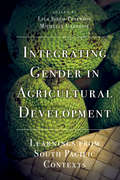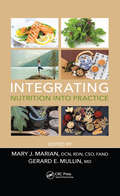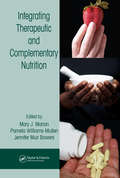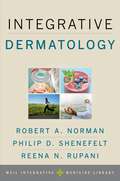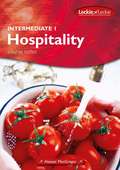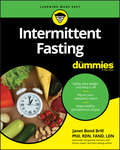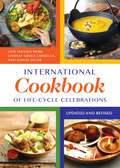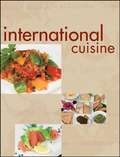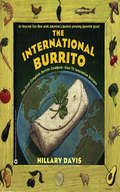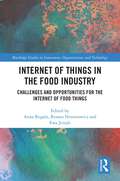- Table View
- List View
Integrating Gender in Agricultural Development: Learnings from South Pacific Contexts
by Lila Singh-Peterson Michelle CarnegieSouth Pacific island nations are committed to international agreements and regional declarations to progress gender equality within their own territories, yet progress towards Sustainable Development Goal 5, Gender Equality, has been reported as slow and uneven. Tackling persistent gender inequalities in agriculture has been identified as a priority due to the industry's commercial importance to economies and communities across the region, and its role in food security. This book is grounded in the ideology that an alignment between the conceptual and practical understandings of gender equality is a critical component of sustainable development. Two introductory chapters establish the book's broader context. The following chapters draw on six rural case studies from Melanesia (Vanuatu, Fiji and Papua New Guinea) and Polynesia (Samoa and Tonga) across cropping, livestock, horticulture and aquaculture sectors to examine the various ways in which gender has been integrated in agricultural research for development projects. The case study authors explore the opportunities and challenges involved in integrating or mainstreaming gender, from research design to implementation, and reflect on the lessons learned. The final chapters synthesise these shared, field-based learnings and positions them within contemporary gender concepts to contribute to an understanding of how they are translated in practice to diverse South Pacific contexts.
Integrating Gender in Agricultural Development: Learnings from South Pacific Contexts
by Lila Singh-Peterson Michelle CarnegieSouth Pacific island nations are committed to international agreements and regional declarations to progress gender equality within their own territories, yet progress towards Sustainable Development Goal 5, Gender Equality, has been reported as slow and uneven. Tackling persistent gender inequalities in agriculture has been identified as a priority due to the industry's commercial importance to economies and communities across the region, and its role in food security. This book is grounded in the ideology that an alignment between the conceptual and practical understandings of gender equality is a critical component of sustainable development. Two introductory chapters establish the book's broader context. The following chapters draw on six rural case studies from Melanesia (Vanuatu, Fiji and Papua New Guinea) and Polynesia (Samoa and Tonga) across cropping, livestock, horticulture and aquaculture sectors to examine the various ways in which gender has been integrated in agricultural research for development projects. The case study authors explore the opportunities and challenges involved in integrating or mainstreaming gender, from research design to implementation, and reflect on the lessons learned. The final chapters synthesise these shared, field-based learnings and positions them within contemporary gender concepts to contribute to an understanding of how they are translated in practice to diverse South Pacific contexts.
Integrating Lifestyle Medicine in Cardiovascular Health and Disease Prevention (Lifestyle Medicine)
by James M. RippeCardiovascular disease (CVD) is the leading cause of morbidity and mortality in the United States and around the world. Major risk factors for CVD result from poor lifestyle habits and practices, but the area of lifestyle medicine has emerged to help clinicians and their patients understand the power of positive lifestyle habits and actions. Written by cardiologist and lifestyle medicine pioneer, Dr. James Rippe, Integrating Lifestyle Medicine in Cardiovascular Health and Disease Prevention introduces the principles of lifestyle medicine with the practice of cardiology to help lower the risk of heart disease and, if already present, assist in its treatment. This book provides evidence-based information on both the prevention and treatment of CVD through lifestyle measures such as regular physical activity, sound nutrition, weight management and avoidance of tobacco products. This information aids physicians and patients to better understand multiple linkages between poor habits and practices, employing them with associated behavioral techniques to lessen the likelihood of developing CVD. Features: Summarizes major issues in CVD including heart attack, stroke, atrial fibrillation, high blood pressure, lipid abnormalities and obesity. Provides protocols for overcoming a sedentary lifestyle and using lifestyle medicine techniques to optimize brain health. Empowers clinicians with vital information for consultations on the power of lifestyle medicine practices, both to treat symptoms if already present or to prevent major components of CVD from developing in the future. Written for practitioners at all levels, this user-friendly volume in the Lifestyle Medicine series is valuable to practitioners in general medicine or subspecialty practices including lifestyle medicine and cardiology.
Integrating Lifestyle Medicine in Cardiovascular Health and Disease Prevention (Lifestyle Medicine)
by James M. RippeCardiovascular disease (CVD) is the leading cause of morbidity and mortality in the United States and around the world. Major risk factors for CVD result from poor lifestyle habits and practices, but the area of lifestyle medicine has emerged to help clinicians and their patients understand the power of positive lifestyle habits and actions. Written by cardiologist and lifestyle medicine pioneer, Dr. James Rippe, Integrating Lifestyle Medicine in Cardiovascular Health and Disease Prevention introduces the principles of lifestyle medicine with the practice of cardiology to help lower the risk of heart disease and, if already present, assist in its treatment. This book provides evidence-based information on both the prevention and treatment of CVD through lifestyle measures such as regular physical activity, sound nutrition, weight management and avoidance of tobacco products. This information aids physicians and patients to better understand multiple linkages between poor habits and practices, employing them with associated behavioral techniques to lessen the likelihood of developing CVD. Features: Summarizes major issues in CVD including heart attack, stroke, atrial fibrillation, high blood pressure, lipid abnormalities and obesity. Provides protocols for overcoming a sedentary lifestyle and using lifestyle medicine techniques to optimize brain health. Empowers clinicians with vital information for consultations on the power of lifestyle medicine practices, both to treat symptoms if already present or to prevent major components of CVD from developing in the future. Written for practitioners at all levels, this user-friendly volume in the Lifestyle Medicine series is valuable to practitioners in general medicine or subspecialty practices including lifestyle medicine and cardiology.
Integrating Nutrition into Practice
by Mary J. Marian Gerard MullinIntegrative medicine is an approach to wellness that makes use of both conventional and alternative therapies to achieve optimal health and healing. Nutrition-based therapies are consistently among the highest used alternative therapies to treat a wide variety of illnesses. This book provides consumers and health care professionals with practical guidance on integrating nutrition therapies into disease prevention and management. It provides reliable and accurate information from experts in the nutrition field including dietitians, nutritionists, physicians, researchers, and academic professionals. Integrative Nutrition Therapy includes up-to-date information on dietary supplements, popular diets, physical activity, and food allergies. The book covers disease prevention for cancer, cardiovascular disease, diabetes, and obesity. Additional topics include liver/pancreatic conditions and musculoskeletal disorders as well as nutrigenomics, epigenetics, and metabolomics. The book provides evidence-based recommendations for which therapies might be appropriate for various conditions and discusses the possible adverse effects that may develop. It also includes guidelines and suggestions for creating individualized, integrative care plans. Integrative Nutrition Therapy is organized in a systematic manner that presents the scientific data using an evidence-based, how-to approach. An overview of integrative medicine is written by Dr. Roberta Lee, a leading authority in the field. Award-winning nutrition experts provide practical knowledge for the integrative practitioner, covering topics such as: Nutrition screening and assessment Search for the optimum diet Functional foods and nutritional supplements Nutritional recommendations for women’s health Health benefits of physical activity Diet and mental health Although unanswered questions still exist, this resource gives you a much-needed guide to the information currently available on nutrition and lifestyle-based therapies.
Integrating Nutrition into Practice
by Mary J. Marian Gerard MullinIntegrative medicine is an approach to wellness that makes use of both conventional and alternative therapies to achieve optimal health and healing. Nutrition-based therapies are consistently among the highest used alternative therapies to treat a wide variety of illnesses. This book provides consumers and health care professionals with practical guidance on integrating nutrition therapies into disease prevention and management. It provides reliable and accurate information from experts in the nutrition field including dietitians, nutritionists, physicians, researchers, and academic professionals. Integrative Nutrition Therapy includes up-to-date information on dietary supplements, popular diets, physical activity, and food allergies. The book covers disease prevention for cancer, cardiovascular disease, diabetes, and obesity. Additional topics include liver/pancreatic conditions and musculoskeletal disorders as well as nutrigenomics, epigenetics, and metabolomics. The book provides evidence-based recommendations for which therapies might be appropriate for various conditions and discusses the possible adverse effects that may develop. It also includes guidelines and suggestions for creating individualized, integrative care plans. Integrative Nutrition Therapy is organized in a systematic manner that presents the scientific data using an evidence-based, how-to approach. An overview of integrative medicine is written by Dr. Roberta Lee, a leading authority in the field. Award-winning nutrition experts provide practical knowledge for the integrative practitioner, covering topics such as: Nutrition screening and assessment Search for the optimum diet Functional foods and nutritional supplements Nutritional recommendations for women’s health Health benefits of physical activity Diet and mental health Although unanswered questions still exist, this resource gives you a much-needed guide to the information currently available on nutrition and lifestyle-based therapies.
Integrating Therapeutic and Complementary Nutrition
by Mary J. Marian Pamela Williams-Mullen Jennifer Muir BowersConsumers look to health professionals for guidance on how to integrate complementary and alternative (CAM) therapies into their lifestyles, yet most health care professionals are trained only in conventional practices. Integrating Therapeutic and Complementary Nutrition provides the scientific foundation necessary to understand CAM nutrition pract
Integrative and Functional Medical Nutrition Therapy: Principles and Practices
by Diana Noland Jeanne A. Drisko Leigh WagnerThis textbook is a practical guide to the application of the philosophy and principles of Integrative and Functional Medical Nutrition Therapy (IFMNT) in the practice of medicine, and the key role nutrition plays in restoring and maintaining wellness. The textbook provides an overview of recent reviews and studies of physiological and biochemical contributions to IFMNT and address nutritional influences in human heath overall, including poor nutrition, genomics, environmental toxicant exposures, fractured human interactions, limited physical movement, stress, sleep deprivation, and other lifestyle factors. Ultimately, this textbook serves to help practitioners, healthcare systems, and policy makers better understand this different and novel approach to complex chronic disorders. It provides the reader with real world examples of applications of the underlying principles and practices of integrative/functional nutrition therapies and presents the most up-to-date intervention strategies and clinical tools to help the reader keep abreast of developments in this emerging specialty field. Many chapters include comprehensive coverage of the topic and clinical applications with supplementary learning features such as case studies, take-home messages, patient and practitioner handouts, algorithms, and suggested readings.Integrative and Functional Medical Nutrition Therapy: Principles and Practices will serve as an invaluable guide for healthcare professionals in their clinical application of nutrition, lifestyle assessment, and intervention for each unique, individual patient.
Integrative Geriatric Nutrition: A Practitioner’s Guide to Dietary Approaches for Older Adults
by Julie Wendt Colleen Considine Mikhail KoganThis book provides a review of therapeutic foods and diets for aging patients. Drawing from extensive clinical experience in large integrative medical practices, it offers a unique and thorough perspective on the challenges that older adults present and the most effective ways to integrate nutritional approaches into their care. Nutritional therapies included here improve patient quality of life via noninvasive, lower cost care and reduce systemic dependencies in a growing demographic. This book looks at condition-specific interventions to equip the practitioner with a thorough understanding of when to call upon specific diet interventions. The text revolves around easily translated clinical tools such as tables, graphs, case studies, and examples to assure multicultural adaptation of evidence-based approaches for conventional use in clinical settings. Integrative Geriatric Nutrition: A Practitioner’s Guide to Dietary Approaches for Older Adults is a concise yet thorough resource for all physicians and medical students who treat aging patients, including geriatricians, nutritionists, family physicians, gastroenterologists, nursing home administrators, nurses, other healthcare providers, geriatric advocates, and inquisitive consumers.
Integrative Health Nursing Interventions for Vulnerable Populations
by Amber VermeeschThis book provides nurses, clinicians, practitioners, educators and students working with vulnerable and underserved populations with essential information on effective wellness strategies to address inadequate nutrition, promote physical activity, and reduce perceived stress through an integrative health nursing framework.It begins with an overview of cultural humility, health inequities, and social justice, establishing the need for an integrative health nursing framework. In turn, the book addresses a broad range of interventions; particular attention is given to wellness strategies designed to prevent the adverse effects of poor nutrition, perceived stress, and lack of physical activity. Written by respected experts in the field, the book offers readers valuable insights into strategies for working with vulnerable populations. Accordingly, it will appeal to researchers working to diminish health inequities among vulnerable populations, and will be of particular interest to nursing educators, practitioners, and students.
Integrative Treatment of Hypertension: A Clinical and Mechanistic Approach
by Joel A. BlushGiven current trends toward obesity, sedentary lifestyles, and poor diets, hypertension is increasingly becoming a disease of the young as well as the elderly, affecting about 1 billion people worldwide. Many patients, especially the younger ones, would prefer alternative treatments. While natural remedies have been used for much longer than pharma
Integrative Weight Management: A Guide for Clinicians (Nutrition and Health)
by Gerard E. Mullin Lawrence J. Cheskin Laura E. MatareseIntegrative Weight Management: A Guide for Clinicians intends to educate physicians and nutritionists about the wide ranges of approaches to weight control from non-traditional sources. The options for weight management in conventional practices are limited to a small number of medications, a confusing array of dietary approaches and surgical procedures with their inherent risks and complications. Unfortunately medical practitioners are not exposed to nutrition and weight control principles during training and thus are reluctant to manage their patients weight control issues. This volume is structured into 4 sections: Introduction to Weight Management Disorders; Morbidity and Mortality of Obesity; Therapy of Obesity; and Integrative Medicine and Obesity. Integrative Weight Management: A Guide for Clinicians represents a powerful collaboration of dozens of leading experts in the fields of nutrition, weight management and integrative medicine who have managed countless numbers of patients and summarized the research from thousands of articles to create an up-to- date state of the art guide for healthcare practitioners, allied health professionals and public health authorities who manage those who are overweight/obese along with the associated metabolic consequences.
Interactive Probiotics
by Enrica PessioneThis book underlines the importance of reciprocal interactions between probiotics and humans in terms of stress induction, epigenetic control of cellular responses, oxidative status, bioactive molecules biosynthesis, moonlighting proteins secretion, endogenous toxins neutralization, and several other biological functions. It explores how these resp
Intermediate 1 Hospitality: Course Notes (PDF)
by Alastair MacgregorThis new title delivers fully relevant comprehensive coverage of the four course units: Food Hygiene for the Hospitality Industry, Hospitality: Organisation of Practical Skills, Food Preparation Techniques and Cookery Processes.
Intermittent and Periodic Fasting, Aging and Disease
by Krista Varady Emily N. C. Manoogian Valter D. LongoThis book is a comprehensive exploration of the science and clinical applications of fasting, with a particular focus on its effects on body weight and metabolic disease risk factors. It delves into various fasting methods, including time-restricted eating, intermittent fasting, alternate day fasting, and periodic fasting.The key concepts explored in this book include the physiological and cellular adaptations to different types of fasting, their impact on body weight and metabolic health, and their potential role in longevity, aging and disease prevention. The book addresses critical questions such as: What are the safety and efficacy of time-restricted eating? How does alternate day fasting affect body weight and metabolic disease risk factors? What are the evolutionary perspectives explaining the clinical benefits of periodic fasting? And how effective is periodic fasting in treating human chronic diseases? This book is aimed at healthcare professionals, researchers, nutritionists, and anyone interested in understanding the science behind fasting. Readers with a scientific or professional background will appreciate the rigorous research and clinical studies presented in this book. They will learn about the latest findings in this field and gain a deeper understanding of how different types of fasting can impact health, wellbeing and aging.
Intermittent Fasting For Dummies
by Janet Bond BrillYou CAN do this! Intermittent fasting made easy. So, you want to begin an intermittent fasting plan and embark on a leaner, healthier and longer life? You probably have already heard about this wildly popular health and fitness diet plan. Intermittent fasting continues to be one of the top google trending diet searches of the year. If you are ready to get on the intermittent fasting bandwagon, then here is the perfect detailed guide to following an intermittent fasting plan of your choice. There are several variations of intermittent fasting, each one is outlined in a step-by-step plan for you to follow. Remember, you choose the style that works best for your lifestyle. The science is in—intermittent fasting has extraordinary health benefits. Intermittent fasting is the key that unlocks everything from sustainable weight and fat loss (especially that stubborn belly fat) to increased mental clarity and a serious boost in energy. Simply by consuming all of your food within a designated time period, you can ramp up your metabolism, reduce the risk of disease, and supercharge your workout or diet programs. No tedious calorie counting, weighing, measuring, or denying yourself your favorite foods. Too good to be true? No, but the trick—as with everything—is doing it in a safe and effective way and Intermittent Fasting For Dummies makes that easy, providing five of the most popular methods and 50+ recipes that will suit any lifestyle or diet. Nutrition and fitness expert—and internationally recognized specialist in disease prevention—Janet Bond Brill shows you how to choose the method that suits you best, as well as guiding you through the science behind intermittent fasting, including how it ignites your fat-burning potential, promotes cellular repair, increases the production of growth hormones, and reduces insulin and blood sugar levels. Choose the right plan and stick to it Make more than 40 health and delicious calorie-controlled meals Maintain your weight loss Improve overall health and prevent disease Wherever you are in your health journey—seeking weight loss or maintaining to promote disease prevention or build muscle—Intermittent Fasting For Dummies shows you how to make the science of "too good to be true" into a truly effective part of your regular, healthy routine.
Intermittent Fasting For Dummies
by Janet Bond BrillYou CAN do this! Intermittent fasting made easy. So, you want to begin an intermittent fasting plan and embark on a leaner, healthier and longer life? You probably have already heard about this wildly popular health and fitness diet plan. Intermittent fasting continues to be one of the top google trending diet searches of the year. If you are ready to get on the intermittent fasting bandwagon, then here is the perfect detailed guide to following an intermittent fasting plan of your choice. There are several variations of intermittent fasting, each one is outlined in a step-by-step plan for you to follow. Remember, you choose the style that works best for your lifestyle. The science is in—intermittent fasting has extraordinary health benefits. Intermittent fasting is the key that unlocks everything from sustainable weight and fat loss (especially that stubborn belly fat) to increased mental clarity and a serious boost in energy. Simply by consuming all of your food within a designated time period, you can ramp up your metabolism, reduce the risk of disease, and supercharge your workout or diet programs. No tedious calorie counting, weighing, measuring, or denying yourself your favorite foods. Too good to be true? No, but the trick—as with everything—is doing it in a safe and effective way and Intermittent Fasting For Dummies makes that easy, providing five of the most popular methods and 50+ recipes that will suit any lifestyle or diet. Nutrition and fitness expert—and internationally recognized specialist in disease prevention—Janet Bond Brill shows you how to choose the method that suits you best, as well as guiding you through the science behind intermittent fasting, including how it ignites your fat-burning potential, promotes cellular repair, increases the production of growth hormones, and reduces insulin and blood sugar levels. Choose the right plan and stick to it Make more than 40 health and delicious calorie-controlled meals Maintain your weight loss Improve overall health and prevent disease Wherever you are in your health journey—seeking weight loss or maintaining to promote disease prevention or build muscle—Intermittent Fasting For Dummies shows you how to make the science of "too good to be true" into a truly effective part of your regular, healthy routine.
International Agricultural Law and Policy: A Rights-Based Approach to Food Security (New Horizons in Environmental and Energy Law series)
by Hope JohnsonFrom soil degradation and biodiversity loss to the coexistence of malnutrition and obesity, many of the largest challenges facing humanity today are underpinned by food and agriculture systems. In order to alleviate and resolve them, global governance of food and agriculture needs to be reformed. Unravelling the array of international regulatory instruments, this timely book provides the first systematic analysis of the international law surrounding food systems. International Agricultural Law and Policy provides a systems-based analysis of the rules that intersect with the physical elements of agriculture against a framework of commonly held norms. The author conducts a comprehensive examination not only of the rules, but also the implementation and broader socioeconomic, scientific and political context. By, exploring and clarifying the relationship between food security and the right to food and sustainability, Johnson closes the gap between the disparate international rules that govern food and agriculture, while exploring the practical implications of these overlapping regimes. This unique book is an invaluable resource for lawyers and social scientists working within food and agriculture systems and their governance and lays the much-needed groundwork for future research. For policy makers in the food and agricultural space, this book provides a wide-ranging and innovative analysis of the global regulatory landscape that influences law and policy processes.
International Cookbook of Life-Cycle Celebrations
by Lois Sinaiko Webb Lindsay Grace Cardella Jeanne JacobMuch more than a cookbook offering a breadth of delicious recipes that honor ethnic traditions and religious customs, this text provides readers with an understanding and appreciation of customs and rites of passage from around the world.International Cookbook of Life-Cycle Celebrations takes readers on a journey around the world and back with an overview of religious customs, specific cultural traditions, and delicious recipes. Readers will learn about unique customs and traditions from more than 150 countries relevant to birth celebrations to weddings to funeral rituals. Although the text is rich with detail, the presentation of information is accessible to general readers and the recipes are kept simple so students of all ages and cooking abilities can execute the dishes and enjoy the results. Organized by continent, region, and then country, the book begins with an overview of religious customs as well as safety and cleanliness tips for cooks. After the introduction, the chapters present information on each country with the specific customs and recipes that correspond to that ethnicity's traditions. The recipes are easy to follow and provide alternatives to complex or hard-to-find ingredients that can be used without jeopardizing the flavor and taste of the end result.
International Cookbook of Life-Cycle Celebrations
by Lois Sinaiko Webb Lindsay Grace Cardella Jeanne JacobMuch more than a cookbook offering a breadth of delicious recipes that honor ethnic traditions and religious customs, this text provides readers with an understanding and appreciation of customs and rites of passage from around the world.International Cookbook of Life-Cycle Celebrations takes readers on a journey around the world and back with an overview of religious customs, specific cultural traditions, and delicious recipes. Readers will learn about unique customs and traditions from more than 150 countries relevant to birth celebrations to weddings to funeral rituals. Although the text is rich with detail, the presentation of information is accessible to general readers and the recipes are kept simple so students of all ages and cooking abilities can execute the dishes and enjoy the results. Organized by continent, region, and then country, the book begins with an overview of religious customs as well as safety and cleanliness tips for cooks. After the introduction, the chapters present information on each country with the specific customs and recipes that correspond to that ethnicity's traditions. The recipes are easy to follow and provide alternatives to complex or hard-to-find ingredients that can be used without jeopardizing the flavor and taste of the end result.
International Cuisine
by The International Culinary Schools at The Art InstitutesThe Best Tool for Learning About the Diversity of Cuisine from Around the World Increasing world travel, changing demographics, multinational business, and greater diversity at home have whetted our appetites for international flavors—whether in national dishes or creative culinary fusions. Anyone entering the foodservice industry today must be prepared to meet this growing demand. Taste truly has gone global. With its comprehensive approach, International Cuisine explores countries and regions, cultures, and ingredients, and describes the crucial role they play in different world cuisines. This comprehensiveand engaging resource gives readers an introductory knowledge of food cultures from five continents, as well as the Caribbean and British Isles. International Cuisine features: A total of 415 authentic recipes, representing all countries and regions discussed Recipes formulated for current practices and available ingredients, including step-by-step instructions Beautiful color photographs illustrating finished dishes An emphasis on sustainability and how locally grown foods enhance cuisines Coverage of history, geography, and people alongside recipes and cooking techniques Detailed ingredients lists and culinary glossaries for each country or region discussed Clearly presented and enjoyable to read, International Cuisine provides students, teachers, and professionals in foodservice a window to a wide variety of the world's cuisines. The Art Institutes (artinstitutes.edu), with more than forty educational institutions located throughout North America, have provided an important source of culinary arts, design, media art, and fashion programs for professionals for more than forty years. Since 1991, The International Culinary Schools at The Art Institutes, with their more than thirty locations, have offered exciting programs in culinary arts featuring a professional kitchen environmentand, in some locations, fully operational restaurants. Students work alongside instructors to learn and perform the hands-on skills chefs use each day. Based on classical Escoffier, Asian, and Latin culinary techniques, with an emphasis on progressive trends and practices, the curriculum is designed to develop and sharpen fundamental cooking techniques and professional skills and introduce a variety of international cuisines.
International Night: A Father and Daughter Cook Their Way Around the World *Including More than 250 Recipes* (International Poetry Nights In Hong Kong Ser.)
by Mark Kurlansky Talia KurlanskyFrom celebrated food writer Mark Kurlansky, a savory trip across the globe for parents and kids, with delicious and accessible recipes and tidbits both cultural and historical.Once a week in the Kurlansky home, Mark spins a globe, and wherever his daughter's finger lands becomes the theme of that Friday night's dinner. Their tradition of International Night has afforded Mark an opportunity to share with his daughter, Talia--and now the readers of International Night--the recipes, stories, and insights he's collected over more than thirty years of traveling the world writing about food, culture, and history, and his charming pen-and-ink drawings, which appear throughout the book.International Night is brimming with recipes for fifty-two special meals--appetizers, a main course, side dishes, and dessert for each--one for every week of the year. Some are old favorites from Mark's repertoire, and others have been gleaned from research. Always, they are his own version, drawn from techniques he learned as a professional chef and from many years of talking to chefs, producers, and household cooks around the world. Despite these insights, every recipe is designed to be carried out--easily--by any amateur chef, and to be completed with the assistance of children. Mark and Talia invite you and your family into their kitchen, outfitted with overflowing packets of exotic spices and aromas of delicacies from Tanzania and Kazakhstan to Cuba and Norway. From there, recipes and toothsome morsels of cultural and historical information will fill your bellies and your minds, and transport you to countries all around the world.
Internationl Burrito
by Hillary Davis David MontielOver 70 recipes help you create memorable dishes in moments - and even inspire you to come up with inventions of your own. Hillary Davis is the author of several sucessful cookbooks, including Garden Entertaining, Celebrate: Traditional Ethnic Entertaining in America, and Great Grilling: Easy and Elegant Entertaining All Year Round.
Internet of Things in the Food Industry: Challenges and Opportunities for the Internet of Food Things (Routledge Studies in Innovation, Organizations and Technology)
by Anna RogalaThe food industry is experiencing a digital transformation across the entire supply chain, from farm to fork. This book offers comprehensive insights into the challenges and opportunities faced, specifically examining the application of the Internet of Things. The authors analyse the benefits and the related threats from the perspective of the participants of the entire supply chain, including consumers. Taking the reader on a journey, this book begins with an analysis of technology use in farming, production, logistics and retailing before delving into the use of digitalization in educating consumers on sustainable consumption practices. The multifaceted analysis of the Internet of Food potential combines science and practice, enriching theoretical analysis with case studies. This book will be of interest to those researching and studying supply chain management, logistics, innovation and technology management and consumption, with a particular interest in the food industry.
